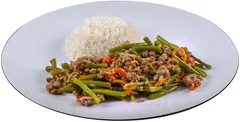
Have you ever wondered if the standard rice portion on your plate might affect the health of your family? For many people, the Filipino meal isn’t complete without rice. However, the experts have now said how much rice—and what else is included in the white grains—is really important. Find out how balancing your plate isn’t only an old-fashioned thing, but could actually allow us to enjoy food for longer and healthier lives. Are you sure that your rice portion is right?
What Is 'Pinggang Pinoy' and Why Should We Care?
Pinggang Pinoy is more than just a buzzword. It’s a visual aid of the Department of Health aimed to assist Pinoys to eat healthy, balanced meals. Imagine a plate that is filled with one-fourth rice and one-fourth protein (like chicken, fish eggs, or fish) and the other half covered with fruits and vegetables. This technique helps us eat not only what we enjoy but also what our bodies actually require for energy and well-being.
The Real Role of Rice on Our Plates

Rice, an essential ingredient of every Filipino table, should be around 14% of your meal—around half cup of cooked rice for adults per meal. However, many people consume a significant portion of their plate with rice. They are and are often not getting enough vegetables and protein. A balanced diet helps reduce weight gain and regulates blood sugar levels, which is especially crucial for families where the disease is becoming more prevalent.
Did you have any idea? The Philippine Department of Health points out that eating plenty of fruits and vegetables—half of your plate—can increase your immunity and reduce the risk of contracting a disease by about 30%.
How Much Rice Is Just Right?
Adults should limit themselves to 1/2 cup of cooked rice per meal, children are advised to limit it to a little less. It’s roughly one-quarter of the size of your fist, or one scoop of ice cream. Rice too much can result in an excess of carbs, spiking blood sugar levels and making it more difficult to keep your weight in control. Plus, many of us eat more rice because our ulam portions are too small or vegetables aren’t present at all.
Building a Balanced Filipino Meal
- Make sure you fill half of your plate vegetables like sayote, okra, kangkong, or sayote as well as some fruits (banana or papaya are excellent choices),
- Add one quarter of your plate to serve protein—think chicken, fish or tofu.
- Limit rice consumption to one-fourth of a plate.
Dietary experts agree that these easy changes can aid Filipinos prevent heart disease as well as control weight and maintain a steady energy level all day. Making these changes is simple even if you’re on a tight budget, particularly when local, fresh produce is utilized.
Why Balance Matters: The Science Behind the Plate
Rice that is too much can mean additional calories—and possible weight gain. The Pinggang Pinoy method provides an easy eye test to ensure that your meals are balanced. Studies have shown that balanced plates containing protein and vegetables help reduce the absorption of sugar and can also reduce the craving for sweets. Filipino families can get the most of each meal by rethinking portions and the ingredients.
In every household that is busy setting up just one or two meals a day using the Pinggang Pinoy plate can make an impact. Not only will you be able to manage your the amount of rice you consume, but you can also inspire everyone at home—lalo na children!—to be exposed to vegetables earlier. Some mothers say it aids in budgeting grocery expenses as less rice means more space for fresh, affordable produce in season.
The Lasting Impact on the Filipino Lifestyle
Adopting the Pinggang Pinoy does not mean sacrificing rice, but rather allowing space for what makes us flourish. With more Pinoys who are health conscious adopt this approach, there’s been an increasing change away from high-carb meals towards healthy, balanced and nutrient-rich meals at home and at sari-sari shops. Imagine how different our lives might be if every family opted for balanced eating, not just eating full, at every meal.
What I’ve learned from my experiences switching dinner plates at home was not just to improve my health. It helped my family reconnect with local, fresh ingredients, and made eating more enjoyable. I can assure you that watching my children reaching to sayote or the kalabasa instead of rice is a tiny victory every single day. When you have Pinggang Pinoy and the goal of achieving an balanced and balanced meal isn’t just feasible, it’s rewarding.
 Meg Magazine
Meg Magazine















Comments